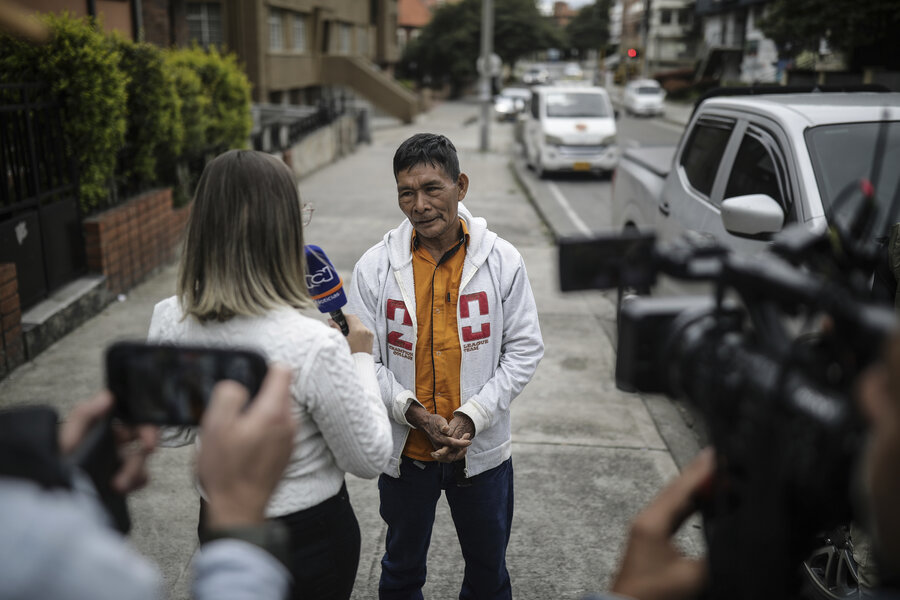40 days after plane crash, children found alive in Colombia
| Bogotá, Colombia
The four Indigenous children who survived 40 days in the Amazon jungle after their plane crashed were recovering Sunday in a military hospital in Colombia, as new details of their harrowing story emerged in a country still mesmerized by their saga.
The kids, aged 13, 9, and 4 years, and 11 months, are expected to remain for at least two weeks in a hospital receiving treatment after their rescue Friday, but some are already speaking and wanting to do more than lying on a bed, according to family members.
Manuel Ranoque, father of the two youngest children, told reporters outside the hospital Sunday that the oldest of the four surviving children – 13-year-old Lesly Jacobombaire Mucutuy – told him their mother was alive for about four days after the plane crashed on May 1 in the Colombian jungle.
Mr. Ranoque said before she died, the mother likely would have told them: “go away,” apparently asking them to leave the wreckage site to survive. He provided no more details.
Fidencio Valencia, a child’s uncle, told media outlet Noticias Caracol the children were starting to talk and one of them said they hid in tree trunks to protect themselves in a jungle area filled with snakes, animals and mosquitoes. He said they were exhausted.
“They at least are already eating, a little, but they are eating,” he said after visiting them at the military hospital in Bogota, Colombia. A day earlier, Defense Minister Iván Velásquez had said the children were being rehydrated and couldn’t eat food yet.
The children were traveling with their mother from the Amazonian village of Araracuara to San Jose del Guaviare when the plane went down.
The Cessna single-engine propeller plane was carrying three adults and the four children when the pilot declared an emergency due to engine failure. The small aircraft fell off the radar a short time later and a search for survivors began.
Dairo Juvenal Mucutuy, another uncle, told local media that one of the kids said he wanted to start walking.
“Uncle, I want shoes, I want to walk, but my feet hurt,” Mr. Mucutuy said the child told him.
“The only thing that I told the kid (was), ‘when you recover, we will play soccer,” he said.
Authorities and family members have said the children survived eating cassava flour and seeds, and that some familiarity with the rainforest’s fruits were also key to their survival. The kids are members of the Huitoto Indigenous group.
After being rescued on Friday, the children were transported in a helicopter to Bogotá and then to the military hospital, where President Gustavo Petro, government and military officials, as well as family members met with the children on Saturday.
An air force video released Friday showed a helicopter using lines to pull the youngsters up because it couldn’t land in the dense rainforest where they were found. The military on Friday tweeted pictures showing a group of soldiers and volunteers posing with the children, who were wrapped in thermal blankets. One of the soldiers held a bottle to the smallest child’s lips.
Gen. Pedro Sanchez, who was in charge of the rescue efforts, said that the children were found 5 kilometers (3 miles) away from the crash site in a small forest clearing. He said rescue teams had passed within 20 to 50 meters (66 to 164 feet) of where the children were found on a couple of occasions but had missed them.
Two weeks after the crash, on May 16, a search team found the plane in a thick patch of the rainforest and recovered the bodies of the three adults on board, but the small children were nowhere to be found.
Soldiers on helicopters dropped boxes of food into the jungle, hoping that it would help sustain the children. Planes flying over the area fired flares to help search crews on the ground at night, and rescuers used speakers that blasted a message recorded by the siblings’ grandmother telling them to stay in one place.
Colombia’s army sent 150 soldiers with dogs into the area, where mist and thick foliage greatly limited visibility. Dozens of volunteers from Indigenous tribes also joined the search.
Mr. Ranoque, the father of the youngest children, said the rescue shows how as an “Indigenous population, we are trained to search” in the middle of the jungle.
“We proved the world that we found the plane... we found the children,” he added.
Some Indigenous community members burned incense as part of a ceremony outside the Bogotá military hospital Sunday to give thanks for the rescue of the kids.
Luis Acosta, coordinator of the Indigenous guard that was part of the search in the Amazon, said the children were found as part of what he called a “combination of ancestral wisdom and Western wisdom... between a military technique and a traditional technique.”
The Colombian government, which is trying to end internal conflicts in the country, has highlighted the joint work of the military and Indigenous communities to find the children.
This story was reported by the Associated Press.






